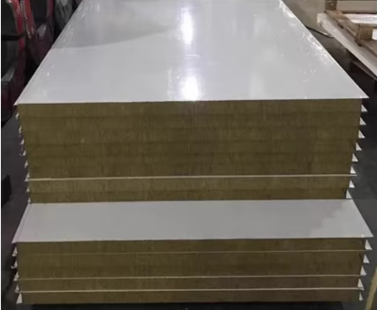Uticaj na okoliš od Sandwich panel Proizvodnja
Procesi proizvodnje i efikasnost resursa
Procesi proizvodnje sandwich panel su dizajnirane da optimizuju efikasnost resursa i smanje potrošnju energije. Tehnike kao što su neprekinuti proizvodni liniji, često korišćene u proizvodnji PU i EPS sendvič ploča, uspostavljaju operacije i minimizuju otpad. Ovi procesi koriste naprednu mašineriju kako bi osigurali tačno sečenje i efikasan korišćenje materijala, što značajno smanjuje količinu sirovina potrebnih u odnosu na tradične građevinske metode. Industrijski izveštaji ističu da su ove inovacije doveli do značajnog smanjenja upotrebe energije, sa nekim fabrikama koje prijavljuju smanjenje do 20% potrošnje energije tijekom proizvodnje. Primenom ovakvih efikasnih praksi, proizvođači mogu da proizvedu više ploča sa manjim ulozima, što doprinosi održivosti sendvič ploča.
Smanjenje proizvodnje otpada u odnosu na tradične materijale
Sandwich panel značajno smanjuje proizvodnju otpada tijekom faza proizvodnje i montaže u odnosu na tradične materijale poput čevlja i betona. Integracija tekstilnih i foam materijala omogućava efikasniji proces, stvarajući manje otpadne dijelove. Studije pokazuju da otpad nastao tijekom instalacije sandvič ploča često iznosi 30-40% manje nego kod tradičnih metoda. Također, zbog svoje modularnosti i preciznosti, sandvič ploče smanjuju vrijeme izgradnje, što znači manje otpada uslijed dužih radnih razdoblja. Istraživanja ukazuju da ovi materijali ne samo da smanjuju trenutni otpad, već doprinosi i dugoročnoj održivosti smanjujući potrebu za materijalima tijekom životnog ciklusa zgrade. Ova učinkovitost čini sandwich panel povoljnijim izborom za ekološki svjestranje građevince koji žele smanjiti svoj ekološki otisak.
Održivi materijali u Sandwich panel Konstrukcija
Eko-prijateljski jezgra materijala: PIR foam i kamenljiva vuna
Korišćenje PIR foam i kamenovune vune u konstrukciji sendvič ploča nudi značajne ekološke prednosti. Obje materijale imaju procese proizvodnje dizajnirane da minimiziraju potrošnju energije i smanje emisije u poređenju sa tradicionalnim izolacionim rešenjima. PIR foam, poznat po svojoj odličnoj termičkoj performansi i trajnosti, često poseduje certifikate poput LEED i BREEAM zbog svojih ekološki prihvatljivih osobina. Kamenovuna vuna, slično tome, nije gorečina, a njena proizvodnja uključuje prehranu šlaka iz proizvodnje ocele, što dodatno podržava održive prakse. Ovi certifikati nisu samo indikatori održivosti već takođe odražavaju pomak u industriji prema zelenijim alternativama.
Korišćenje recikliranog celika i mineralnih sastojaka
Integracija preobnovljene čelika i mineralnih sastojaka u sandvič pločama je ključna za smanjenje ukupnog ugljikovog stopa. Uvođenjem preobnovljenih materijala, proizvođači znatno mogu smanjiti emisije uključene u proizvodnji ovih materijala. Obično, sandvič ploče sadrže do 75% preobnovljenog sadržaja, što demonstrira pristup ka održivim građevinskim praksama. Nadalje, slučajevi istraživanja ističu uspješne projekte koji koriste preobnovljene materijale, potvrđujući njihovu učinkovitost i efikasnost. Ovi primjeri potvrđuju mogućnost upotrebe preobnovljenih materijala za ispunjavanje suvremenih građevinskih zahteva, širenjem krugove ekonomije u graditeljskom sektoru.
Energetska učinkovitost i smanjenje ugljikovog prašca
Termalna izolacija svojstva za štednju operativne energije
Панели сандвич обезбеђују изузетне термалне изолацијске особине које воде до значајних енергетских уштеда током рада зграде. Ови панели чине ефективне барјере против губитака топлоте, одржавајући стабилну температуру унутар зграда и смањујући потребу за интензивним отопљавањем или хлађењем. Утицај ове уштеде осећа се не само у смањеним оперативним трошковима већ и у побољшаном раду зграде током времена. На пример, истраживања показују да енергетски ефикасне зграде које користе панеле сандвич могу постићи смањења до 40% у потрошњи енергије у односу на традиционалне материјале. Као резултат, ови панели не само што доприносе одрживости већ такође нуде финансијске уштеде предузећима током њиховог животног циклуса.
Смањење емисија CO2 током животног циклуса зграда
Korišćenje sendvič ploča u gradnji značajno smanjuje emisiju CO2 tijekom životnog vremena. Ugradnjom naprednih izolacionih materijala, ove ploče smanjuju ugljikov pragan zgrada. Komparativni podaci pokazuju da zgrade koje koriste sendvič ploče mogu imati za do 30% manje emisije CO2 u odnosu na one izgrađene konvencionalnim materijalima. Ovo smanjenje podržava istraživanja fokusirana na emisiju stakleničkih plinova, ističući učinkovitost sendvič ploča u postizanju značajnog smanjenja emisije CO2. Takva prednosti održivosti ističu prijateljski odnos prema okruženju sendvič ploča, čime se one postaju mudri izbor za ekološki svjestran gradbeništvo.
Trajanost i smanjene potrebe za zamjenom
Trajanje sendvič ploča značajno doprinosi smanjenju potrebe za zameno i popravkom. Ove ploče, često izrađene od materijala poput PIR/PUR, prikazuju izuzetnu dugovrednost zbog svoje čvrstoće i otpornosti na razne environske uslove. Na primer, uz moguće ranjivosti u solenim okruženjima, njihov dugački životni vek smanjuje česte zamene. Ovo trajanje dovodi do manje trošnje resursa tokom vremena i istaknuto je u različitim slučajevima studija gde su sendvič ploče konstantno premašile tradične materijale u pogledu dugovrednosti i performansi.
Procesi zatvorenog ponovnog koriscenja za ocel i jezgra materijale
Procesi zatvorenog šematskog reciklaže za čeljuste i jezgra koristene u sandvič pločama fokusiraju se na održivost. Ovi procesi su dizajnirani da efikasno recikliraju i metalne komponente i izolacione jezgre, time smanjujući otpad koji ide na smetiste. Čelik, pošto je vrlo reciklabilan, igra ključnu ulogu u stvaranju održivog životnog ciklusa za ove ploče. Mnoge inicijative i firme su uspešno implementirale sisteme zatvorenog šematskog reciklaže, demonstrirajući potencijal ovih procesa u promociji okolišne održivosti. Praktične primene ističu smanjenje otpada, prikazujući korak prema efikasnim industrijskim praksama reciklaže.
Porekljivanje sa standardima zelenog građevinarstva
Prilozi certifikacijama LEED i BREEAM
Панели сандвич значајно доприносе постигнућу сертификата LEED и BREEAM, који су есенцијални за зелене građevinarske vjerodajnice. Ове престижне сертификације оцењују одрживост зграде и често истакну енергијску ефикасност, управљање водом и минималан утицај на средину. Коришћење панела сандвич у градњи може помоћи да се из[strlen]пуне ови критеријуми због њихове одличне термичке изолације и особина штедње енергије. Ови панели помажу у постицању енергијских перформансних кредитова, који су клjučni za LEED i BREEAM, смањивањем потрошње енергије зграде и њеног угљеничког отпаца. Следствено, њихова примена подржава цилеве сертификације и обезбеђује преследовање одговорних градитељских пракса у односу на средину.
Улога у постицању циљева зграда са нултом енергије
Панели сандвич играју клjuчну улогу у постигнувaњу циљева зграда сa нет нуловој енергијом побољшавањем енергетског ефикасност. Нjихове својstва изoлациje знатно смањују потpебе за грејањем и хлађењем, што су првобитни потрошачи енергије у зградама. На primer, броjne проjектe су имплементирале ове панеле да минимизују коришћење енергије, постигнувши приближно нулту чисту консумцију енергије. Ово је често додатно обезбеђено возобновљивим изворима енергије да компензирају bило које преостале потребе за енергијом. Такви примери истакну вредност панела сандвич у покретању одрживог graђевинства што удовољава строге енvirонменталне циљеве, кonaлно доводећи до смањеног угљеног отпаца и pobољшане одрживости у градитељском окружењу.
Чести питања o екологиjском uticajу панела сандвич
Шта чini панеле сандвич екологиjски приhvatљивим?
Панели сандвич су dizajnirani sa proizvodnim procesima koji su efikasni u korišćenju resursa, koriste ekološki prijateljsке materijale kao što su PIR foam и камена вуна, а такође садрже рехабилитовane компоненте, што заједно смањује производњу отпада и угљеног отиска.
Kako sendvič ploče doprinose energetskoj učinkovitosti?
Ови панели нуде одличну термалну изолацију, што смањује потребу за грејањем и хлађењем, а следствено и потрошњу енергије у зградама.
Да ли могу панели сандвич помоћи у постицању сертификата за зелене зграде?
Да, панели сандвич значајно доприносе сертификацији LEED и BREEAM zbog својих особина шtedања енергије и трајног развоја.
Садржај
- Uticaj na okoliš od Sandwich panel Proizvodnja
- Održivi materijali u Sandwich panel Konstrukcija
- Energetska učinkovitost i smanjenje ugljikovog prašca
- Trajanost i smanjene potrebe za zamjenom
- Procesi zatvorenog ponovnog koriscenja za ocel i jezgra materijale
- Porekljivanje sa standardima zelenog građevinarstva
- Чести питања o екологиjском uticajу панела сандвич

 EN
EN







































